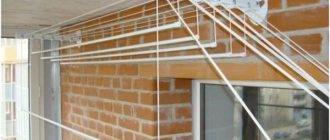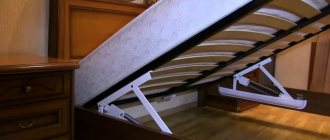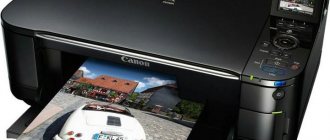Why does it break?
It would seem that the dryer is designed so simply that it should not break down at all. Those that were made half a century ago still adorn loggias and balconies to this day. But this cannot be said about some modern products - sometimes they break down within a year, or even earlier.
The reason is simple: in old dryers, all parts are made of high-quality metal, while in modern ones, plastic is often used. For example, in cheap models with an adjustable rope there are plastic gears along which the cord moves. Such details wear out quite quickly, and the rope begins to jam - neither here nor there.
What else might a clothes dryer repair involve? The rods periodically fall off if the model is made of bad metal. And all sorts of troubles happen with the legs of floor dryers. In short, this item is not as simple as it seems, and accordingly, it needs care, attention and timely repairs.
Manufacturers
Ceiling clothes dryers: how to choose a suitable design
The German company Leifheit (the leader in Russian sales), the Italians Melicone and Gimi, Dogrular from Turkey are leading companies in sales and quality with a good name in the market. However, the brand affects the price. For example, Leifheit products start from 2000 rubles, Gimi - from 700.
The best Chinese and Delta. Prices from 500 rubles.
Whatever manufacturer you choose, be sure to read the product characteristics when purchasing: the material from which the dryer is made, coating, types of strings.
Each dryer has a number of advantages and disadvantages, this must be taken into account when choosing.
“Liana” is a difficult structure to install. You will have to re-read the instructions more than once. In addition, the retractable ropes are fixed with a plastic mount on the wall. Part of the weight of the laundry falls on this fastener, and plastic is plastic. However, among housewives this model is recognized as the leader in convenience.
Any long dryers have a slight sag. Therefore, if you choose a 1.8 meter long dryer, the ideal material for it would be stainless steel, not plastic.
If you choose a short dryer, the strings should not be too thin, otherwise it will not withstand anything other than socks and T-shirts.
What types of dryers are there?
The simplest dryer is a frame made of metal or plastic on which rods are attached. Depending on the location, the models are:
- floor;
- ceiling;
- wall;
- mounted
Important! The first two types are the most popular; they are the ones that break most often. On sale you can find quite complex high-tech products with a microlift, remote control, etc. They are quite expensive, and electronics almost always have to be repaired, so it is better to contact a service center.
Installation and repair of clothes dryer in the bathroom | For home, for family
Hello dear readers of the site sesaga.ru. In this article I want to share my experience on how to install and repair a clothes dryer in the bathroom .
Before renovation (new)
After renovating the bathroom, the question arose of how to make a clothes dryer. The proven old-fashioned method of driving in self-tapping screws and securing clotheslines to them immediately disappeared.
We decided to join civilization and buy a wall-mounted clothes dryer. Out of all the variety of dryers to choose from, I liked this model. I don’t remember whose production, but not China.
The first problem arose with the installation, since there were no instructions or pictures. The repair kit included: two corner hooks, two self-tapping screws, four dowels and a plate with a hole.
But I finally figured out how to install the dryer.
Installing a clothes dryer
We center and mark where the dryer should be located on the wall. First of all, we install a block with a drum - a tensioner on which the rope is wound.
First, we attach the plate, then we insert the right edge of the block with the drum into it, move it to the left until it stops, and after that we mark the hole for the self-tapping screw on the left side of the block.
At the next stage we attach the counter part. Here I recommend taking a “level” and an assistant.
We stretch the counter part to the opposite wall. Here, an assistant applies a level to the rope and helps you level the mating part in height. You can do it by eye, but there is a possibility of making a mistake.
We draw two lines with a pencil - at the top and bottom of the response part. Now we align the counter part horizontally and diagonally, and make markings for the brackets to which it will be attached.
When you attach the mating part to the wall, pay attention to the fact that the brackets “look” down, since the mating part is put on them from the bottom up. The picture on the right shows where the staples go.
But over time, the working ropes begin to sag, and all attempts to tighten them did not lead to anything good.
Here it turns out that the rope is snake-like and evenly distributed throughout the tensioner drum, passing through the ear holes of the mating part.
That is, leaving the first window of the block with a drum, the rope is passed through two ear holes of the mating part, returns to the second window of the block, is again wound onto the drum and comes out of the third window, etc. It is precisely because of this winding that sagging occurs.
After another pull, the second ear in the back of the clothes dryer broke.
I didn’t want to throw it away or buy exactly the same one and have to suffer with it in the same way. Moreover, the holes in the wall have already been made, and making new ones is also not an option. What if the new dryer doesn’t fit?
Gear wear
How to repair a clothes dryer if the rope does not want to move? In this case, you will need a new gear. In principle, you can buy it in a store that sells all kinds of fasteners. If you have an old sewing machine at home that no one needs, but it’s a pity to throw it away, you can remove the necessary part from it - it was used for winding threads.
Important! This is better because old machines used high-quality metal components, so your gear will last for decades in its new quality.
If you have obtained the required part, proceed in the following order:
- Find the metal pin that holds the wheel in place.
- Take it out - this is easy to do with pliers.
- The worn gear is located in special grooves - pull it out from there.
- Place the new part in the same grooves.
- Check if the design works.
- If you hear a squeak, lubricate the rod with machine oil.
Important! Do not use vegetable oil for such purposes - it is an organic substance and is not particularly useful for metal.
We repair crossbars
In dryers, mainly crossbars made of two materials are used:
- plastic;
- metal
Important! In some models there are also wooden ones, but this is relatively rare, and besides, it is much easier to repair such a dryer than others. The wood can simply be glued together - most special adhesives hold such a load perfectly. As a rule, such crossbars do not fall off the frame. As for plastic, any repair will be a one-time thing, so it’s better to just replace the cheap dryer with a new one.
There are several ways to repair a metal crossbar:
- using nylon ties;
- using wire;
- cold welding method;
- in some cases it can be soldered;
- replace the rod with a longer one and fasten it with self-tapping screws;
- weld.
Nylon zip ties
The simplest, but also the least reliable way. In order to fix a clothes dryer this way, you will need:
- nylon cord;
- epoxy resin;
- drill;
- metal drill.
The result should be something like a fastening made of composite material. The method is not the most convenient, but the repair will not take much time. The dryer will still serve for some time:
- Drill identical through holes in the frame and in the rod.
- Thread the cord through them and tighten them properly.
- Make several turns on the crossbar and on the frame - preferably crosswise.
- Fill the mounting area with epoxy.
- After the structure has dried, the dryer can be used.
Wire
This method is also unreliable, besides, the attachment point looks extremely unaesthetic, and you will have to hang the laundry with care. But still, consider this option for repairing a dryer with your own hands:
- Drill through holes.
- Insert thin steel wire into them.
- Screw the rod to the frame.
Important! Wire should only be used from stainless steel, otherwise the laundry can be damaged.
Cold welding
It is made using a special composition. In fact, it is a special glue that provides a fairly strong connection. You can buy it at a hardware store, but you must act strictly according to the instructions. In this case, there is no need to drill anything. True, those who have ever used dryers that were repaired in this way claim that the connection does not hold for very long, and it is not worth hanging heavy laundry on this rod.
But you can combine two methods:
- We drill holes in the frame and rod.
- Apply the composition to a piece of steel wire.
- We pass the wire through the holes.
- We wrap sections of the frame and rod.
- Let it harden.
Soldering iron
It is very tempting to attach the rod by soldering. In some cases this is possible and gives good results. For example, if the crossbars and frame are made of stainless steel, there are no problems; this metal is connected in this way quite easily and firmly. But this method is not suitable for aluminum.
Self-tapping screws, screws and more
The crossbar can be screwed on using any fasteners you have on hand. Not a bad fastening method, but if the connection is not done very carefully, there is a risk of tearing the linen.
To fix a clothes dryer yourself, you will need:
- narrow steel strip;
- self-tapping screws or screws with nuts;
- vice;
- drill;
- metal drills;
- marker.
The strip must be bent at an angle of 90° and 2 holes drilled at the ends. Then we proceed like this:
- Attach the crossbar to the frame as it stood when it was in good working order.
- Attach a metal strip from below so that its corner coincides with the junction of the rod and the body.
- Mark the locations for the holes.
- Drill through holes.
- Secure the entire structure with screws or self-tapping screws.
Important! For greater strength, you can attach the strip to universal glue or epoxy.
Bend the rod
If it is possible to bend or flatten the rod, extend it or replace it with a longer one, you can do this:
- Bend the edge of the crossbar down 5-10 mm.
- Drill a hole in the frame so that it matches the bend.
- Insert the curved end into the housing.
- Wrap it all with electrical tape or fill it with epoxy.
Important! The most reliable method is spot welding: for prevention, you can weld the joints of other crossbars.
see also
Comments 115
I tied the torn rods back in place with thin steel wire. Then I coated the top with glue from a hot-melt gun so that the ends of the wire would not cling. There was always a welding mark on the rods, due to which the rod does not slip out of the wire. The glue cools down and turns white and the wire does not show much on the white dryer catches your eye.
Each cable must be tensioned separately because it will stretch quickly.
By pulling each cable separately, you will end up with two knots for each installation, and as you know, tying a cable is very difficult. If you use special fasteners for fastening, then this will again involve additional costs and the massiveness of the product. If the cable stretches out in my case, then it is enough to untie (try to untie) one loop and tighten everything again.
So you don’t have to cut the cable right away, you can push it through entirely☝️
I didn't understand anything from your comment. I have three pieces of cable: the middle, and on the sides on the “ears”. You wrote to tighten separately - as I understand it, this means to tighten each string separately... write more clearly, not everyone understands you.
Here you go











